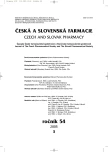Antioxidative Activity of Some Over-the-Counter Plant Extracts
Authors:
J. Muselík; P. Hytych 1; M. Žemlička 1
Authors‘ workplace:
Veterinární a farmaceutická univerzita Brno, Farmaceutická fakulta, Ústav technologie léků
; Veterinární a farmaceutická univerzita Brno, Farmaceutická fakulta, Ústav chemických léčiv
1
Published in:
Čes. slov. Farm., 2005; 54, 114-117
Category:
Original Articles
Overview
The recent years again saw increased interest of the public in the use of traditional natural remedies, such as plant extracts, for the treatment and prevention of diseases. This paper evaluates the antioxidative activity and content of phenolic substances of selected plant extracts from medicinal herbs, sold as dietary supplements with therapeutic effects. Using the production of 3-nitrotyrosine as the marker, the effects of extracts on the inhibition of peroxynitrite-induced nitration of tyrosine was examined, and the results were compared with the ability to extinguish the stable radical 2,2-diphenyl-1-picrylhydrazyl (DPPH). A linear correlation (r = 0.929) was found between the ability to extinguish DPPH and to inhibit tyrosine nitration. The found antioxidative activity ranged between values of 0-1702, or 0-1482 μmol of the catechine equivalent/100 ml of the extract. The total content of phenolic substances oscillated within values of 9.4–268.3 mg of the equivalent of gallic acid/100 ml of the extract. The significant linear relationship between antioxidative activities (r>0.9) and the total content of phenolic substances shows that phenolic substances are the principal group responsible for the antioxidative activity of the extracts tested.
Key words:
peroxynitrite – 3-nitrotyrosine – DPPH – antioxidants – Ginkgo biloba
Labels
Pharmacy Clinical pharmacologyArticle was published in
Czech and Slovak Pharmacy

2005 Issue 3
Most read in this issue
- Solubilization and Complexation of the Antileukotrienic Drug Quinlukast in Aqueous Solutions of Cyclodextrins
- A Study of the Properties of Compacts from a Mixed Dry Binder on the Base of α-Lactose Monohydrate and Microcrystalline Cellulose
- Xanthium spinosum L. – a Phytochemical Study
- Comparison of the Consumption of Antiepileptic Drugs in the Czech Republic, Scandinavia, and Australia
